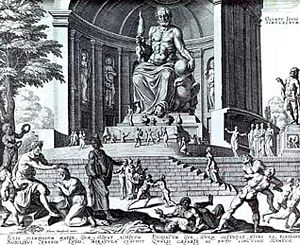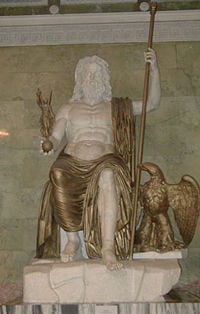Difference between revisions of "Statue of Zeus at Olympia" - New World Encyclopedia
m |
|||
| Line 9: | Line 9: | ||
Perhaps the greatest [[Discovery (observation)|discovery]] in terms of finding out about this wonder came in [[1958]] with the excavation of the workshop [http://www.anistor.co.hol.gr/english/enback/a041.htm] used to create the statue. This has led archaeologists to be able to re-create the technique used to make the great work. | Perhaps the greatest [[Discovery (observation)|discovery]] in terms of finding out about this wonder came in [[1958]] with the excavation of the workshop [http://www.anistor.co.hol.gr/english/enback/a041.htm] used to create the statue. This has led archaeologists to be able to re-create the technique used to make the great work. | ||
| − | + | [[Image:Zeus Hermitage St. Petersburg 20021009.jpg|thumb|200px|Roman ''Seated Zeus'', marble and bronze (restored), following the type established by Phidias, (Hermitage Museum).]] | |
| − | [[Image:Forngrekiska mynt från Elis med bilder efter Fidias staty av Zeus i Olympias Zeustempel.jpg|thumb|right|Coin of [[Elis]] illustrating the Olympian Zeus | + | |
| + | [[Image:Forngrekiska mynt från Elis med bilder efter Fidias staty av Zeus i Olympias Zeustempel.jpg|thumb|right|Coin of [[Elis]] illustrating the Olympian Zeus ''.]] | ||
==Zeus== | ==Zeus== | ||
| − | + | blah blah blah | |
| − | |||
==Olympic Games== | ==Olympic Games== | ||
Revision as of 01:18, 3 May 2007
The Statue of Zeus at Olympia is one of the classical Seven Wonders of the Ancient World. It was carved by the famed Classical sculptor Phidias circa 435 B.C.E. in Olympia, Greece.[1]
The seated statue occupied the whole width of the aisle of the temple that was built to house it, and was 40 feet. "It seems that if Zeus were to stand up," the geographer Strabo noted early in the 1st century B.C.E., "he would unroof the temple."[2] Zeus was a chryselephantine sculpture, made of ivory and accented with gold plating. In the sculpture, he was seated on a magnificent throne of cedarwood, inlaid with ivory, gold, ebony, and precious stones. In Zeus' right hand there was a small statue of Nike, the goddess of victory, and in his left hand, a shining sceptre on which an eagle perched.[3] Plutarch, in his Life of the Roman general Aemilius Paulus, records that the victor over Macedon “was moved to his soul, as if he had beheld the god in person,” while the Greek orator Dio Chrysostom wrote that a single glimpse of the statue would make a man forget his earthly troubles.
Perhaps the greatest discovery in terms of finding out about this wonder came in 1958 with the excavation of the workshop [1] used to create the statue. This has led archaeologists to be able to re-create the technique used to make the great work.
Zeus
blah blah blah
Olympic Games
Destruction
The circumstances of its eventual destruction are a source of debate: some scholars argue that it perished with the temple in the fifth century AD, others argue that it was carried off to Constantinople, where it was destroyed in the great fire of the Lauseion (Schobel 1965). According to Lucian of Samosata in the later second century, "they have laid hands on your person at Olympia, my lord High-Thunderer, and you had not the energy to wake the dogs or call in the neighbours; surely they might have come to the rescue and caught the fellows before they had finished packing up the swag."[4] A common line of thought suggests it was destroyed by a meteor.
ReferencesISBN links support NWE through referral fees
- Bernard and Yalouris. Olympia: The Sculptures of the Temples of Zeus, Phaidon, 1967. ASIN B000NKQ3NU
- Dillon, Matthew, Pilgrims and Pilgrimage in Ancient Greece, Routledge, 1997. ISBN 978-0415127752
- Nardo, Don. Greek Temples, Franklin Watts, 2002. ISBN 978-o531162255
- Pedley, John. Sanctuaries and the Sacred in the Ancient World, Cambridge University Press, 2005. ISBN 978-6521809351
Credits
New World Encyclopedia writers and editors rewrote and completed the Wikipedia article in accordance with New World Encyclopedia standards. This article abides by terms of the Creative Commons CC-by-sa 3.0 License (CC-by-sa), which may be used and disseminated with proper attribution. Credit is due under the terms of this license that can reference both the New World Encyclopedia contributors and the selfless volunteer contributors of the Wikimedia Foundation. To cite this article click here for a list of acceptable citing formats.The history of earlier contributions by wikipedians is accessible to researchers here:
The history of this article since it was imported to New World Encyclopedia:
Note: Some restrictions may apply to use of individual images which are separately licensed.
- ↑ Statue of Zeus from encyclopædiabritannica.com. Retrieved on 2006-11-22.
- ↑ The Seven Wonders: The Statue of Zeus at Olympia by Alaa K. Ashmawy from ce.eng.usf.edu. Retrieved on 2006-11-22.
- ↑ "On his head is a sculpted wreath of olive sprays. In his right hand he holds a figure of Victory made from ivory and gold... In his left hand, he holds a sceptre inlaid with every kind of metal, with an eagle perched on the sceptre. His sandals are made of gold, as is his robe. His garments are carved with animals and with lilies. The throne is decorated with gold, precious stones, ebony, and ivory." (Pausanias, Description of Greece 5.11.1-.10)
- ↑ Lucian's dialogue (Timon the Misanthrope) On-line.

